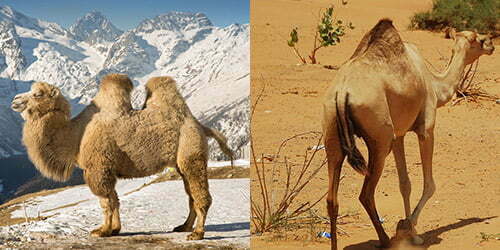Yes, camels have tails. Similar to other animals, camels’ tails are flexible appendages attached to the torso of the animals.
The tail of a camel helps it with everyday functioning but also plays a critical role during the mating season. More on that later in the article.
Let’s first describe the appearance of the tail.

Table of Contents
What Does A Camel’s Tail Look Like?
Camel tail is an elongated part of the camel’s body attached to the base of its back. It consists of 15 to 20 slender and rod-shaped vertebrae. Camel’s tail is tufted and covered in hair.

It is quite flexible and can move in different directions; different positions of the tail have different meanings.
For example, when a camel is relaxed, the tail is let to hang down loose.
When a camel is excited, angry, or pregnant, it will usually lift its tail parallel to the ground, or bend it towards its back.
When a camel is in a rut, it will flip its tail, and move it up and down. [1]
Most of the time, when a camel is to urinate or defecate, it will move its tail away from the stream.
Do Camels Have Long Tails?
Camels do have long tails. Their tails can be between 1.5 and 2.1 feet long (45-65 cm), depending on the camel species. Bactrian camels have longer tails than dromedary ones. Bactrian tail is 1.7-2.1 feet (51-65cm), while the Dromedary tail is 1.5-1.8 feet long (45-55cm).
A breed of camels in Saudi Arabia, the Meghem camels, are said to be able to grow tails up to 2.8 feet long (85 cm). [2]
However, compared to other bigger animals, camels mostly have shorter tails.
For example, compared to giraffes, who can have tails around 2.5 and 3.6 feet long (76-110 cm), camels have shorter tails. Giraffe’s tail can, in some cases, can grow up to 8 feet long (2.4 m).
Further reading: Is a camel related to a giraffe?
Compared to African elephants, the largest land mammals, camels have shorter tails. Elephants have tails 3.25-5 ft long (1-1.5 m), while camels have around 2.1 feet long ones.
Compared to rhinos, the second largest land mammals, camels have shorter tails – rhinos have tails between 25 and 30 inches long.
Compared to black Bengal goats, whose tails are between 0.26 and 0.36 feet long (8-11 cm), camels have longer tails. [3]
Compared to Sindhi donkeys, who have a tail length between 1.4 and 2.1 feet (43-65 cm), camels have similar tail lengths. [4]
Compared to Kankrej Cows, camels have shorter tails. These cows have tails up to 3.6 feet long (111 cm).
| Animal | Tail Length |
| Giraffe | 2.5-3.6 ft |
| African Elephant | 3.25-5 ft |
| Black Bengal Goat | 0.26-0.36 ft |
| Sindhi Donkey | 1.4-2.1 ft |
| Konkrej Cow | 3.6 ft |
| Camel | 1.5-2.1 ft |
Camel’s South American cousins, llamas have 6-12 inches long (15-30 cm) tails.
What Do Camels Use Their Tails For?
Camels use their tail in a variety of ways. Most of the time, camels use their tails to keep away the pests from biting them and to cool themselves down. During a rutting season, camels will use their tail as part of their mating rituals.
Similar to other land animals, camels use their tails to brush away flies and other biting insects. A camel’s waving tail forms a curtain of air that can prevent most insects from reaching them, it blows them away, or kills them if they get on its body.
During hot desert days, a camel might urinate on its tail, and then wag the tail to spread their pee on their legs to help them cool down. Such camels are easy to notice, as they have black crusty stains on their back legs.
When the mating season comes and when camels get into heat, male camels’ tails will be constantly soaked with urine. As the male urinates, the tail is constantly flipped between the legs. It will then hurl it over its back and spread the urine everywhere. The result is a foul-smelling mixture of urine, dirt, and black ooze that is dripping behind their ears when they are in heat.
Female camels will lift their tails when in oestrus (female heat) and around male camels. If they fling around their tails when approached by a male camel or a rider – this can be interpreted as a sign of pregnancy.
We have a full article on why camels have long tails, make sure to check it out if you want to learn more.
A Camel With No Tail
In 2012, a camel calf with no tail was admitted to Veterinary Hospital in the United Arab Emirates. It was diagnosed with a rare disorder, a congenital absence of the tail (anury).
Such tailless condition has been known to have a hereditary or congenital origin. However, in this case, the cause of such a defect could not be confirmed. Conditions like these rarely occur in camels.
What was interesting here, is that both the mother and the father of the calf had normal tails. [5]
Camel Ticks – A Camel Tail Menace
Hyalomma dromedarii – also known as the camel tick, is a hard-bodied blood-feeding ectoparasite that affects the health of camels. It affects the wellbeing of camels with irritating bites, blood loss, damage to the skin, and by causing dangerous health problems.
A study from 2020 discovered that in 502 examined animals, the highest number of ticks on the body of the camel was found on the tail area. The ticks would hide under the tail and feed near the anal opening, benefiting from the tender tissues and moisture. [6]
These parasites are also dangerous to humans, as they can transmit diseases to the people interacting with camels.
Final Thoughts
And there you have it! Do camels have tails – answered in much bigger detail than you probably asked for.
Camels do have tails. They are the hindmost prolonged part of the animal attached to its torso. Camel tail is between 1.5 and 2.1 feet long and consists of 15-20 vertebrae. It is hairy and tufted and is used to sway insects and to attract mates.
We hope you found the article interesting, and if you reached this part of the article, kudos to you.
Reference
[1] Medicine and Surgery of Camelids, Murray Fowler, 2011
[2] Al-Hazmi, M. A., A. M. Ghandour, and M. Elgohar. “A study of the biometry of some breeds of Arabian camel (came/us dromedarius) in Saudi Arabia.” Science 6.1 (1994).
[3] Jalil, M. A., et al. “Morphometric characterization of Black Bengal Goat under farming condition in Bangladesh.” Asian Journal of Medical and Biological Research 4.1 (2018): 95-104.
[4] Behl, Rahul, et al. “Comparison of three types of Indian donkey populations based on morphometric characteristics.” Journal of Livestock Biodiversity 7.1 (2017): 17-21.
[5] Anwar, S., and G. N. Purohit. “Rare congenital absence of tail (anury) and anus (atresia ani) in male camel (Camelus dromedarius) calf.” Open veterinary journal 2.1 (2012): 69-71.
[6] Al-Deeb, Mohammad Ali, and Sabir Bin Muzaffar. “Prevalence, distribution on host’s body, and chemical control of camel ticks Hyalomma dromedarii in the United Arab Emirates.” Veterinary world 13.1 (2020): 114.